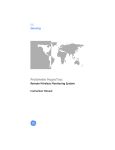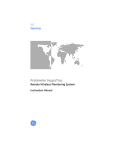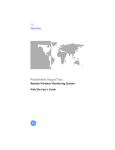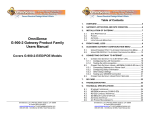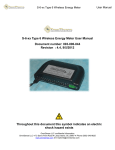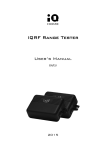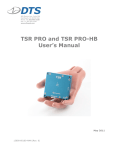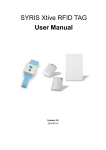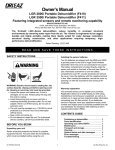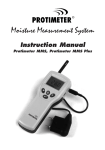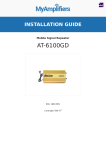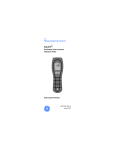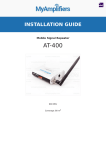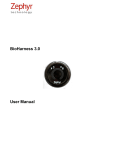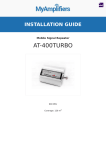Download Manual - Test Equipment Depot
Transcript
GE Measurement & Control Moisture HygroTrac Instruction Manual 99 Washington Street Melrose, MA 02176 Phone 781-665-1400 Toll Free 1-800-517-8431 Visit us at www.TestEquipmentDepot.com INS9000 Rev. D June 2012 GE Measurement & Control Solutions Moisture HygroTrac Moisture Transmitter Instruction Manual INS9000 Rev. D June 2012 INS9000 Rev. D June 2012 [no content intended for this page - proceed to next page] ii Contents 1. 2. 3. 4. 5. 6. 7. Introduction . . . . . . . . . . . . . . . . . . . . . . . . . . . . . . . . . . . . . . . . . . . . . . . . . . . . 1 System Components . . . . . . . . . . . . . . . . . . . . . . . . . . . . . . . . . . . . . . . . . . . . . 1 HygroTrac Applications . . . . . . . . . . . . . . . . . . . . . . . . . . . . . . . . . . . . . . . . . . 3 3.1 Permanent Installations . . . . . . . . . . . . . . . . . . . . . . . . . . . . . . . . . . . . . 3 3.2 Temporary Installations . . . . . . . . . . . . . . . . . . . . . . . . . . . . . . . . . . . . . 3 Installation . . . . . . . . . . . . . . . . . . . . . . . . . . . . . . . . . . . . . . . . . . . . . . . . . . . . . 3 4.1 Wireless Sensors . . . . . . . . . . . . . . . . . . . . . . . . . . . . . . . . . . . . . . . . . . 4 4.2 Data Acquisition Gateway . . . . . . . . . . . . . . . . . . . . . . . . . . . . . . . . . . . 6 4.3 Gateway Activation and Site Creation. . . . . . . . . . . . . . . . . . . . . . . . . . 6 4.4 Gateway Installation Guidelines . . . . . . . . . . . . . . . . . . . . . . . . . . . . . . 7 4.4aLocation Preparation . . . . . . . . . . . . . . . . . . . . . . . . . . . . . . . . . . . . . . 7 4.4bPower . . . . . . . . . . . . . . . . . . . . . . . . . . . . . . . . . . . . . . . . . . . . . . . . . 7 4.4cAntenna . . . . . . . . . . . . . . . . . . . . . . . . . . . . . . . . . . . . . . . . . . . . . . . . 7 4.4dLocation and Mounting . . . . . . . . . . . . . . . . . . . . . . . . . . . . . . . . . . . . 7 4.4eRear Panel LEDs . . . . . . . . . . . . . . . . . . . . . . . . . . . . . . . . . . . . . . . . . 8 4.4fAccessing Gateway Configuration Menu . . . . . . . . . . . . . . . . . . . . . . 9 4.4gUsing Ethernet Port to Access Configuration Menu. . . . . . . . . . . . . . 9 4.4hUsing the RS-232 Port to Access the Configuration Menu . . . . . . . 12 4.5 Connecting the Gateway to the Internet . . . . . . . . . . . . . . . . . . . . . . . 16 4.5aConnecting the Gateway to an Ethernet LAN. . . . . . . . . . . . . . . . . . 16 4.5bConnecting the Gateway Using Proxy Servers . . . . . . . . . . . . . . . . . 17 4.5cConnecting the Gateway Using a Modem. . . . . . . . . . . . . . . . . . . . . 17 4.6 Secure Digital (SD) Card. . . . . . . . . . . . . . . . . . . . . . . . . . . . . . . . . . . 19 Operation . . . . . . . . . . . . . . . . . . . . . . . . . . . . . . . . . . . . . . . . . . . . . . . . . . . . . 21 5.1 Web Data Service. . . . . . . . . . . . . . . . . . . . . . . . . . . . . . . . . . . . . . . . . 21 5.2 Viewing the Data . . . . . . . . . . . . . . . . . . . . . . . . . . . . . . . . . . . . . . . . . 22 Troubleshooting. . . . . . . . . . . . . . . . . . . . . . . . . . . . . . . . . . . . . . . . . . . . . . . . 23 Technical Specifications . . . . . . . . . . . . . . . . . . . . . . . . . . . . . . . . . . . . . . . . . 25 7.1 Wireless Sensor . . . . . . . . . . . . . . . . . . . . . . . . . . . . . . . . . . . . . . . . . . 25 7.2 %RH/Temperature Sensor . . . . . . . . . . . . . . . . . . . . . . . . . . . . . . . . . . 25 7.3 Moisture Sensor . . . . . . . . . . . . . . . . . . . . . . . . . . . . . . . . . . . . . . . . . . 25 7.4 Data Acquisition Gateway . . . . . . . . . . . . . . . . . . . . . . . . . . . . . . . . . . 26 7.5 Certification . . . . . . . . . . . . . . . . . . . . . . . . . . . . . . . . . . . . . . . . . . . . . 26 HygroTrac Instruction Manual iii Contents iv HygroTrac Instruction Manual 1. Introduction The Protimeter HygroTrac is a simple and cost effective system for remotely monitoring moisture and temperature levels in buildings. The Protimeter HygroTrac system measures and logs parameters such as the following: • • • • • GPP or g/kg dew point temperature relative humidity air temperature % moisture in wood To set up the system, small HygroTrac wireless sensors are placed in the building. Sensor readings are transmitted to a Data Acquisition Gateway, which is connected to a dedicated and secure web server via either an Ethernet or telephone line connection. 2. System Components The Protimeter HygroTrac kit comprises a carry case containing the components detailed in Table 1 below. Figure 1 on the next page shows a typical BLD9000 kit. Table 1: Protimeter HygroTrac Kit (BLD9000) Description Hard Carry Case with Custom Foam Insert Data Acquisition Gateway* Detachable Antenna w/RP-SMA connector 10 Wireless Sensors w/Lithium Batteries* 20 Conductive Mounting Screws 3.3v Power Supply Ethernet Cable (RJ 45) Telephone Cable (RJ 11) Instruction Manual *Additional sensors (BLD9050) and gateways (BLD9010) are available. For European use, append “-EU” to the part numbers. HygroTrac Instruction Manual 1 2. System Components (cont.) Figure 1: BLD9000 Kit 2 HygroTrac Instruction Manual 3. HygroTrac Applications 3.1 Permanent Installations The Protimeter HygroTrac system provides warnings of potential moisture-related problems that can lead to property damage or health risks. This makes it ideal for locations such as: • heritage and historic buildings • museums • food storage • apartment buildings 3.2 Temporary Installations The Protimeter HygroTrac system can be used in restoration projects to reduce costly regular visits to take moisture and humidity measurements when drying a building after water damage. HygroTrac may be used to: • automatically produce detailed professional reports • get output readings from dehumidifiers • provide early warnings of targets reached and potential problems through e-mail alerts and cellular text messages 4. Installation A complete installation of your Protimeter HygroTrac system includes the wireless sensors, the data acquisition gateway and website access. IMPORTANT: The external power supply included in your HygroTrac BLD9000 kit is fitted with an AC plug suitable for the country of destination. If you require a different plug, please contact GE Measurement & Control for assistance. IMPORTANT: See the Declaration of Conformity at the end of this manual for HygroTrac certification information. HygroTrac Instruction Manual 3 4.1 Wireless Sensors A photograph of a HygroTrac wireless sensor is shown at the right. To install your wireless sensors, complete the following steps: 1. To help determine the best locations for the sensors, use a standard moisture meter such as the Protimeter Surveymaster to establish the existing moisture conditions within the building. 2. Select up to 600 sensor locations that are within 150 ft (50 m) of the planned location of the data acquisition gateway. Note: The maximum sensor transmission distance varies with the building construction materials. Also, if more than 600 sensors are required, additional gateways will be needed. You may also need additional gateways if your sensors are out of the sensor RF transmission range due to distance or building construction materials. CAUTION! 3. If it becomes necessary to replace a sensor battery, use only a LISUN #ER14505 lithium battery and be sure to install it with the correct polarity. Use of any other battery or installation of the battery with the incorrect polarity will void your sensor warranty. When mounting the sensors, observe the following precautions: a. If you use a powered screwdriver, be careful not to overtighten the screws. The screws should be just tight enough to ensure good contact between the material and the sensor. b. Avoid placing sensors in locations where they could be stepped on or in locations where they might interfere with working machinery. c. Do not mount sensors in areas where water could enter the electronic components. 4 HygroTrac Instruction Manual 4.1 Wireless Sensors (cont.) 4. Fix each HygroTrac wireless sensor at its chosen location using two of the supplied conductive mounting screws. As the mounting screws are also the terminals for the moisture sensor, the HygroTrac moisture reading is taken at the depth of the screw in the material. For measurements deeper in the material, you can substitute longer screws obtained from a local supplier. However, the screws must be made from stainless steel. The photograph at the right shows a sensor mounted to the wall above a doorway. IMPORTANT: You must be sure to use a spring washer with each mounting screw to maintain the integrity of the connection, as the material expands and contracts with moisture changes. 5. Record the ID number and location of all installed sensors. The sensors have bar-coded ID numbers for use with bar-code readers when installing large numbers of sensors (see photograph on previous page). HygroTrac Instruction Manual 5 4.2 Data Acquisition Gateway To install your Data Acquisition Gateway, refer to Figure 2 below and proceed to the instructions in the next section. Antenna Phone Line Port SD Card Slot RS232 Port LAN Port Power Input Figure 2: Data Acquisition Gateway - Rear Panel 4.3 Gateway Activation and Site Creation A gateway sends all the data it collects to the HygroTrac Database Server (HDS). Users can then access this data at www.gehygrotrac.com (the detailed instructions in the GE HygroTrac Web Site User’s Guide are provided on the site). To store and access data, users must: 1. Activate the gateway and assign it to a user-created “site”. 2. Register as a subscriber. 3. Create sites by logging into your account and providing information that describes the site to be monitored (customer name, address, email, etc.). 4. Assign one or more gateways to that site. Note: When sensors send data through a gateway assigned to a site, those sensors are automatically assigned to that site as well. Record the gateway ID which is on the ID label located on the bottom of the gateway. You will need this ID in order to activate your gateway at www.gehygrotrac.com. 6 HygroTrac Instruction Manual 4.4 4.4a Gateway Installation Guidelines Location Preparation When planning your installation, remember that the gateway requires an AC power source and either a LAN or modem Internet connection. Also, position the gateway as centrally as possible to the planned sensor locations. 4.4b Power The gateway requires 3.3 VDC, provided by the supplied AC adapter. Connect the adapter to an AC power source and plug the jack into the “3.3VDC” receptacle on the gateway rear panel. When power is active, the PWR LED will be on. 4.4c Antenna The antenna supplied with your gateway connects to the “Antenna” connector on the gateway rear panel. It should be screwed on finger tight. The antenna is designed to swivel in all directions and must be pointed skyward, or vertically oriented, for best wireless performance. 4.4d Location and Mounting The gateway can either be wall mounted using the built in teardrop-shaped mounting holes on the bottom of the case (screws not supplied) or it can be placed on any horizontal surface. In either case, be sure the antenna is pointed skyward. For best system wireless coverage, locate the gateway central to where the sensors are to be installed. Do not locate the gateway close to large metal obstructions such as filing cabinets or refrigerators. HygroTrac Instruction Manual 7 4.4e Rear Panel LEDs The gateway rear panel, shown in Figure 3 below, contains several LEDs which provide useful information on the status of the gateway. Figure 3: Data Acquisition Gateway - Rear Panel LED Detail The LEDs indicate the following information: Wireless • TX LED – consistent rapid flashing indicates normal transmitter operation. • RX LED – flashes briefly while the gateway is receiving data over the wireless link. The activity of this LED depends on the number of sensors in your system and the sensor reporting interval. • Status LED – lit when gateway is communicating normally with the OmniSense Database Server (ODS). Modem • Link LED – flashes to indicate the modem is attempting to dial out; steady light indicates the modem is connected to the remote modem • Act LED – when lit, indicates the gateway has successfully logged in to your ISP; flashes to indicate the sending and receiving of packets LAN • Speed LED – always off, indicating 10 Mb/s link speed • Link LED – Ethernet link is active; flashes to indicate the transmission or receipt of packets • PWR – when lit, indicates power is on 8 HygroTrac Instruction Manual 4.4f Accessing Gateway Configuration Menu Note: For LAN connections, no configuration changes are usually necessary. For modem connections, ISP login, password, and phone number are necessary. To change the gateway configuration, users must enter the configuration menu. You can access this menu via either the Ethernet port connection or the RS-232 port connection, using a standard RS232 cable with DB-9 connectors (not supplied). Either connection provides access to the same menu settings. 4.4g Using Ethernet Port to Access Configuration Menu Use the following steps to access the configuration menu via the LAN connection: 1. Disable and disconnect ALL network connections on your laptop/PC except for the LAN connection, and then reboot your PC so that the LAN connection will use an Auto Assigned IP Address. 2. Connect the gateway to your laptop/PC using the supplied Ethernet cable. 3. Apply power to the gateway, and verify that the LAN Link LED is lit and/or flashes. Note: If the LAN Link LED does not go on and/or flash, you will need to use an Ethernet crossover adapter or an Ethernet Hub. 4. Wait for ~30 seconds while the PC assigns itself an Auto IP address. 5. On your PC, verify that it has assigned itself the correct Auto IP address using “Start>Run” to execute the command “cmd /K ipconfig” as shown below. Click OK. HygroTrac Instruction Manual 9 4.4 Data Acquisition Gateway (cont.) 6. The windows IP configuration window will open. Note that any 169.254.xxx.xxx address is acceptable and your address need not exactly match the sample address shown below. 7. On your PC, connect to the gateway configuration menu using Start>Run to execute the command telnet 169.254.1.1 9999 and click OK, as shown below. You should see a new window similar to the one shown below. 10 HygroTrac Instruction Manual 4.4 Data Acquisition Gateway (cont.) Note: If this command fails, then it is likely your PC is not using an auto assigned IP address. Make sure you that have followed the instructions in Step 1 on page 9. 8. Press the spacebar to access the configuration menu and to view the current gateway settings. You should see the menu shown below. 9. You can then modify individual settings by selecting the desired menu item. Note: Be sure to save your changes; saving changes forces a reboot which will disconnect your telnet session from the gateway. HygroTrac Instruction Manual 11 4.4h Using the RS-232 Port to Access the Configuration Menu Complete the following steps to access the configuration menu via the RS-232 port connection. IMPORTANT: Be sure the gateway is unplugged from the power source. 1. Connect the gateway RS-232 port to your PC’s COM port (usually, but not always, designated “COM1”) using a serial cable (not supplied). 2. On your PC start a HyperTerminal window (shown below) using Start>Run to execute the command hypertrm. Click OK. 3. At the prompt, enter a name (see below) for the new connection and click OK. 12 HygroTrac Instruction Manual 4.4h Using the RS-232 Port to Access the Configuration Menu (cont.) 4. You will then be prompted to select the gateway connection (see below); usually the connection is through the COM1 port, but it will vary from PC to PC, and in some cases may be through a serial adapter on a USB port. Select the appropriate COM port name and click OK. 5. Follow prompts to enter the COM port settings. Configure the COM port with the following settings and click OK. • • • • • Bits per second: 57600 Data Bits: 8 Parity: None Stop bits: 1 Flow control: None HygroTrac Instruction Manual 13 4.4h Using the RS-232 Port to Access the Configuration Menu (cont.) 6. You are now ready to power on the gateway. Power on the gateway and your HyperTerminal window should resemble the screen shown below. If you have problems, be sure that the HyperTerminal window is the currently selected window on your desktop and that you do not currently have any text selected in the HyperTerminal window. 14 HygroTrac Instruction Manual 4.4h Using RS-232 Port to Access Configuration Menu (cont.) 7. Press the spacebar within 5 seconds of power-up to access the gateway configuration menu. 8. You can now modify individual settings by selecting the desired menu item. Remember to save your changes. HygroTrac Instruction Manual 15 4.5 Connecting the Gateway to the Internet If a LAN connection is present, the gateway will automatically use it. If the LAN connection is inactive, the gateway will attempt to dial out until it reaches the maximum number of dial retries. Note that if you have an active LAN connection, but you want the gateway to use the MODEM connection, you must change the gateway settings from “Auto Detect Connection” to “Use MODEM Connection”. 4.5a Connecting the Gateway to an Ethernet LAN Using the supplied Ethernet cable, connect the gateway’s “LAN” port to an available and active data port on your LAN network. Power on the gateway, and the Link LED should come on within 1-2 seconds. If it does not, see the troubleshooting chart on page 23. 1. Configuring the LAN Connection The gateway is shipped from the factory to plug-and-play with most common LAN environments, but from time to time you may need to change the settings to be compatible with “non-standard” LAN environments. Some possible LAN configurations include: • Setting a non-zero “LAN static IP”, “LAN default gateway IP” and “LAN subnet mask” Note: You should use a static IP address only if instructed to do so by your network administrator. • Setting the “LAN Static IP” to 000.000.000.000 (this is the factory default), which forces the gateway to use DHCP to acquire an IP address from your network’s DHCP server. Note: If no DHCP server is found, the gateway will default to an auto-assigned IP address of 169.254.1.1 and will continue to try to get a DHCP assigned address as well. 16 HygroTrac Instruction Manual 4.5a Connecting the Gateway to an Ethernet LAN (cont.) 2. Testing the LAN connection If the Status LED lights up, the LAN connection is working. If the Status LED does not light up, the LAN connection is not working (see Troubleshooting on page 23). 4.5b Connecting the Gateway Using Proxy Servers Some networks, especially large corporate networks, block users from direct access to the Internet. Instead, users must access the Internet through a proxy server. The gateway can operate with proxy servers; you must set the gateway’s “Remote Server IP” to the IP address of the network’s proxy server. If you do not know the proxy server IP address, contact your network administrator. To set your gateway back for use in a standard (i.e., no proxy server) network environment, set the “Remote Server IP” to 69.68.219.155. 4.5c Connecting the Gateway Using a Modem You must have a working dialup account in order to use the modem. 1. Connecting the Gateway to a Phone Jack Connect the gateway to an active analog telephone jack using the supplied RJ-11 phone cable or a similar phone cable, as shown below. Residential phone lines are typically analog, while office lines are digital. In an office you should use a phone line that can support a fax/modem. Note: The modem interface is surge protected by a non-replaceable non-resetting slow-blow fuse. If you use a phone line that experiences frequent surges or lightning strikes, you should put a surge protector in line with the gateway to protect the modem from damage. HygroTrac Instruction Manual 17 4.5c Connecting the Gateway Using a Modem (cont.) 2. Configuring Dialup Information The gateway requires your Internet Service Provider (ISP) phone number, user name, and password. You must set these parameters using the New Customer Registration menu. In most cases, one ISP account can support many gateways and, in the event your ISP only allows a single login at a time, the gateway will continue to attempt to login until it reaches the maximum number of retries. 3. Other Dialup Settings In most office environments, you will need to dial “9” for an outside line, in which case you should change the dialup number on the configuration menu to include a dialing prefix of “9,”. For example: “Set dialup number(9,18666633679)” Be sure to include the comma, as it instructs the modem to pause before dialing the next number, and the pause is required to wait for a dial tone from the outside line. You can also configure the time between server connection attempts and the maximum number of dialup retries used during a connection attempt. By limiting the number of dialup retries, you can prevent the modem from monopolizing the phone line in the event your ISP is not responding. The gateway configuration menu also has a configuration option to allow you to specify a “Modem Custom AT command string”. This string is used only to permit operation of the modem outside of North America. 4. Testing Your Modem Connection First, power up the gateway. If the LAN cable is disconnected or if you have manually configured the gateway to the “Use MODEM Connection” option, the gateway will always attempt to dial up the configured ISP such that you can get immediate confirmation at the time of installation that the modem connection is working. If the Status LED lights up, and you must watch it carefully as in most cases it will only stay on for a few seconds, the modem connection is working. See the section Troubleshooting (page 23) if you do not see the Status LED come on. 18 HygroTrac Instruction Manual 4.6 Secure Digital (SD) Card The preferred mode of Protimeter HygroTrac operation is through one of the direct Internet connections. Direct connection permits immediate access to any automated warnings that may be generated by the system. However, anytime an Internet connection is not active, the gateway will store data to either the internal flash memory or the optional Secure Digital (SD) Card if it is present. (You can then upload this data to the HygroTrac web site by bringing the gateway to a location that can provide access to your Internet account.) To set up your HygroTrac system with an SD card: 1. Purchase an SD card from a local supplier. Note: A 128 MB SD card will support 10 sensors, reporting every five minutes for 728 days. 2. Use a computer with an SD card reader to format the new SD card with an MS Windows FAT file system. 3. Insert the SD card into the slot on the back of the data acquisition gateway (see below). CAUTION! 4. Use only the GE Measurement & Control power supply provided with your HygroTrac kit. The use of non-factory power supplies may damage the equipment and will void your warranty. Connect one end of the power supply to your data acquisition gateway (see the photograph on page 17), and plug the other end into a suitable AC outlet. As the gateway does not have an ON/OFF switch, connection and plugging in will immediately power up the gateway. HygroTrac Instruction Manual 19 4.6 Secure Digital (SD) Card (cont.) 5. To upload your SD card data to the HygroTrac web site, bring the gateway to a location where a connection to your Ethernet/dial-up Internet account can be made. Upload time depends on the amount of data, but typically takes a few minutes. Note: The gateway includes onboard flash data storage that is sufficient for one year of data, with ten sensors each reporting every hour. To upload data from the internal flash storage, use Step 5 above. GE recommends the use of an SD Card only if your data storage needs exceed the capacity of the onboard flash storage. 20 HygroTrac Instruction Manual 5. Operation As soon as the Protimeter HygroTrac system is installed and powered up, as described in the previous section, it begins collecting data. In order to access this data, follow the instructions in this section. 5.1 Web Data Service Note: Please refer to the GE HygroTrac Web Site User’s Manual for detailed information on setting up the web site. The HygroTrac data is stored on a dedicated and secure web server. To access your data, complete the following steps: Note: There is a monthly fee for the HygroTrac service account. 1. Using your existing internet connection, go to the following URL: 2. Choose one of the following options: a. If you already have an account, simply log in. b. If you do not already have an account, create a new user account and accept the terms and conditions. c. View the online “Web Site User Guide” for any required help. 3. Follow the online instructions to view your data. HygroTrac Instruction Manual 21 5.2 Viewing the Data After you access your HygroTrac account, the following data is available for each data point from each sensor, by sensor ID and description: • Time and date • Temperature • Relative Humidity • Wood Moisture Equivalent (%WME) • Grains per Pound (GPP) or g/kg • Dewpoint temperature (°C or °F) From your HygroTrac account, you can perform the following functions: • Name the individual sensors to indicate their locations • View and graph near-live data • View dewpoint, GPP, temperature, % RH, and % WME data • Set alarms and thresholds that automatically send e-mails or mobile phone text messages • Produce automatically generated reports • Set up multiple users with different access levels • Download data in a text file format for importing into a spreadsheet and other applications 22 HygroTrac Instruction Manual 6. Troubleshooting Table 2 below describes possible problems and their solutions. Table 2: Troubleshooting the LAN/Ethernet Connection Problem Cause Solution LAN Link LED is on, but Status LED never comes on The LAN connection the Verify the LAN port you are using Gateway is using does not can access the Internet. have Internet access because Internet connection is down or does not exist. The LAN connection the See page 17 for operating with a Gateway is using does not proxy server. have direct Internet access because network uses a proxy server. LAN Link LED The LAN Ethernet port does not come you are using is not on active. Make sure the Ethernet jack you are using is active; check with another computer or laptop. The Ethernet cable is not Check the Ethernet cable plugged in. connections and make sure they “click” when the plugs are pushed in. The LAN Ethernet port you are using is configured as a client. Use an Ethernet crossover adapter. The Ethernet cable is bad. Replace the Ethernet cable. Status LED is Gateway out of range of ON, but when I sensors. log on to the website, I do not see my data Move gateway closer to sensors. Not all of my sensors are Active on the website Relocate gateway closer to sensors or add additional gateway(s) to expand wireless coverage. Gateway out of range of sensors. HygroTrac Instruction Manual 23 Table 2: Troubleshooting the LAN/Ethernet Connection (cont.) Problem Cause Solution MODEM Link LED goes solidly on, but Act LED never flashes Bad username and/or password Verify username and password are correct. MODEM Link No dial tone Verify phone line has dial tone LED goes solid Bad dialup phone number Verify dialup phone number is correct Missing DSL filter 24 Assuming your phone line is used for DSL service, add DSL filter to the line. HygroTrac Instruction Manual 7. 7.1 Technical Specifications Wireless Sensor Transmission Distance*: 150 ft (50 m) nominal Transmission Frequency: 902.2 - 907.8 MHz; 868.2, 868.4, 869 MHz (EU) Size (l x w x h): 2.25 x 1.5 x 2.25 in. (60 x 30 x 60 mm) Weight: 2.42 oz (68 g) *Transmission distance varies with many factors, including the presence of obstacles such as concrete walls and interference from other electronic equipment. 7.2 %RH/Temperature Sensor Range: 0 to 100% (non-condensing) Accuracy: 10 to 90% ±2.5% Temperature Range: -40 to 185°F (-40 to 85°C) Temperature Accuracy: ±1°F (±0.5°C) at 77°F (25°C) Battery Life: 15 years nominal, when reporting hourly 7.3 Moisture Sensor Resistance: pin type Range: 8 to 40% Accuracy: ±1% in wood, 10 to 25% subject to adjustments for species and temperature Calibration Temperature: 68°F (20°C) HygroTrac Instruction Manual 25 7.4 Data Acquisition Gateway Maximum Inputs: 600 sensors Data Transmission: to secure Internet via 10 Mb/s Ethernet output or dial on-demand telephone modem Onboard Data Storage: approximately 1 year of data with 10 sensors each reporting hourly Additional Data Storage: up to 2 GB on SD card (not supplied) Size (l x w x h): 7.5 x 4.9 x 1.6 in. (190 x 125 x 40 mm) Weight: 10.8 oz (305 g) Power Input: 3.3 VDC external power supply (included) 7.5 Certification See the Declaration of Conformity at the end of this manual. The information contained in this manual is given in good faith. As the method of use of the instrument (and its accessories) and the interpretation of the readings are beyond the control of the manufacturers, they cannot accept responsibility for any loss, consequential or otherwise, resulting from its use. 26 HygroTrac Instruction Manual GE Sensing DECLARATION OF CONFORMITY DOC-0039, Rev. A We, GE Sensing 1100 Technology Park Drive Billerica, MA 01821 USA declare under our sole responsibility that the Protimeter HygroTrac™ Remote Wireless Environmental Monitoring System to which this declaration relates, is in conformity with the following standards: For US and Canada Models Only • FCC Part 15 This Product Contains Transmitter Module FCC ID: RY20002. This equipment complies with Parts 15 of the Federal Communications Commission (FCC) rules for the United States. Operation is subject to the following two conditions: (1) this device may not cause interference, and (2) this device must accept any interference, including interference that may cause undesired operation of the device. The equipment has been tested and found to comply with part 15 of the FCC rules. These limits are designed to provide reasonable protection against harmful interference in a residential installation. This equipment generates, uses and can radiate radio frequency energy and, if not installed and used in accordance with the instructions, may cause harmful interference to radio communications. However, there is no guarantee that interference will not occur in a particular installation. If this equipment does cause harmful interference to radio or television reception, which can be determined by turning the equipment off and on, the user is encouraged to try and correct the interference by one or more of the following measures: • Reorient or relocate the receiving antenna. • Increase the separation between the equipment and receiver. • Connect the equipment into an outlet or on a circuit different from that to which the receiver is connected. • Consult the dealer or an experienced radio/TV technician for help. FCC Part 15 Warning: Changes or modifications to this unit not expressly approved by the party responsible for compliance could void the user's authority to operate the equipment. • Industry Canada (IC) This Product Contains Transmitter Module IC ID:6474A-0002. This digital apparatus does not exceed the Class B limits for radio noise emissions from digital apparatus set out in the interference causing equipment standard entitled Digital Apparatus, ICES-003 of Industry Canada. This device complies with Canadian RSS-210 regulations. NOTICE: The Industry Canada (IC) label identifies certified equipment. The Department does not guarantee the equipment will operate to the user’s satisfaction. Page 1 of 2

































